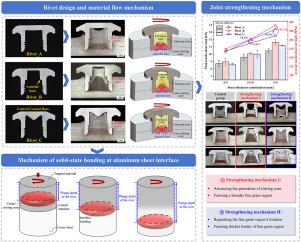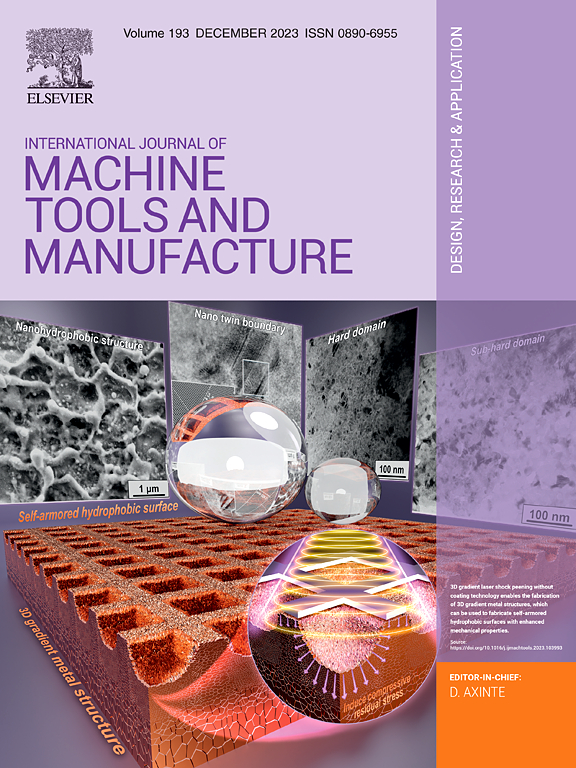通过量身定制的铆钉结构操纵搅拌区的几何形状来强化平模摩擦自冲铆接接头
IF 18.8
1区 工程技术
Q1 ENGINEERING, MANUFACTURING
International Journal of Machine Tools & Manufacture
Pub Date : 2024-10-19
DOI:10.1016/j.ijmachtools.2024.104223
引用次数: 0
摘要
实现表面平整的高强度接缝对于降低风阻和提高美观度具有重要意义。本研究提出了一种新型平模摩擦自冲铆接(平模 F-SPR)工艺。通过对铆钉结构的精密设计,实现了无模具导向的铆钉翻边。设计了三种具有不同内部结构的铆钉,以控制连接过程中的材料流动和微观结构演变。基于急停方法,研究了使用不同铆钉制造的接头的载荷-行程曲线、宏观形态和微观结构的演变。提出了接头固态粘接的新机制,以阐明细晶粒区域的生成和演变。结果表明,当铆钉腔内的材料受到向下的压力时,会出现一个中心搅拌区。通过使用环形凸台结构的铆钉,基体材料不断流入搅拌区并在铆钉腔内堆积,形成了独特的锥形细晶粒区。最后,根据不同的下片厚度,对不同类型接头的强度和断裂模式的转变进行了综合评估。与 Rivet_A 的接头相比,Rivet_B 和 Rivet_C 的接头强度分别提高了 11.1% 和 6.9%。本文提出了提高固态粘接强度的两种策略,为铆钉结构的优化提供了启示。本文章由计算机程序翻译,如有差异,请以英文原文为准。

Strengthening flat-die friction self-pierce riveting joints via manipulating stir zone geometry by tailored rivet structures
Achieving high-strength joints with flat surfaces is of significant importance for reducing wind resistance and enhancing aesthetic appeal. In this study, a novel flat-die friction self-piercing riveting (flat-die F-SPR) process is proposed. The rivet flaring without die guidance was achieved through the sophisticated design of rivet structures. Three types of rivets with different internal structures were designed to manipulate the material flow and microstructure evolution during the joining process. Based on the method of emergency stop, the load-stroke curves, evolutions of macroscopic morphology, and microstructure of the joints made with different rivets were investigated. A novel mechanism for solid-state bonding of joints was proposed to elucidate the generation and evolution of fine grain regions. The results indicate when downward pressure is applied to the material inside the rivet cavity, a central stirring zone appears. By using a rivet with an annular boss structure, the base material flows continuously into the stirring zone and piled up in the rivet cavity, forming a unique conical-shaped fine grain zone. Finally, a comprehensive assessment of the strength of different types of joints and the transition of the fracture modes were conducted based on different lower sheet thicknesses. The joints of Rivet_B and Rivet_C demonstrate 11.1 % and 6.9 % strength enhancement compared with the joint of Rivet_A, respectively. Two strategies for enhancing the strength of solid-state bonding are proposed, which offers insights for the optimizations of rivet structures.
求助全文
通过发布文献求助,成功后即可免费获取论文全文。
去求助
来源期刊
CiteScore
25.70
自引率
10.00%
发文量
66
审稿时长
18 days
期刊介绍:
The International Journal of Machine Tools and Manufacture is dedicated to advancing scientific comprehension of the fundamental mechanics involved in processes and machines utilized in the manufacturing of engineering components. While the primary focus is on metals, the journal also explores applications in composites, ceramics, and other structural or functional materials. The coverage includes a diverse range of topics:
- Essential mechanics of processes involving material removal, accretion, and deformation, encompassing solid, semi-solid, or particulate forms.
- Significant scientific advancements in existing or new processes and machines.
- In-depth characterization of workpiece materials (structure/surfaces) through advanced techniques (e.g., SEM, EDS, TEM, EBSD, AES, Raman spectroscopy) to unveil new phenomenological aspects governing manufacturing processes.
- Tool design, utilization, and comprehensive studies of failure mechanisms.
- Innovative concepts of machine tools, fixtures, and tool holders supported by modeling and demonstrations relevant to manufacturing processes within the journal's scope.
- Novel scientific contributions exploring interactions between the machine tool, control system, software design, and processes.
- Studies elucidating specific mechanisms governing niche processes (e.g., ultra-high precision, nano/atomic level manufacturing with either mechanical or non-mechanical "tools").
- Innovative approaches, underpinned by thorough scientific analysis, addressing emerging or breakthrough processes (e.g., bio-inspired manufacturing) and/or applications (e.g., ultra-high precision optics).

 求助内容:
求助内容: 应助结果提醒方式:
应助结果提醒方式:


